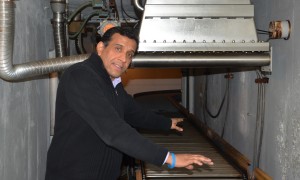eBeam Center receives $899,000 research grant from EPA
- Writer: Adam Russell, 903-834-6191, [email protected]
- Contact: Suresh Pillai, 979-458-3229, [email protected]
COLLEGE STATION – Texas A&M AgriLife Research’s National Center for Electron Beam Research at Texas A&M University announced receipt of a research grant to investigate practical uses of eBeam technology to address environmental issues.

Suresh Pillai, Ph.D., director of the center, and his team received $899,000 from the Environmental Protection Agency’s National Center for Environmental Research. The three-year study hopes to identify possible eBeam applications for remediation of environmental contaminants and waste, including wastewater and sewage sludge.
“We have a history of success with this technology, and the EPA is another agency interested in researching how eBeam could be of use in environmental applications,” Pillai said. “We are excited and optimistic about the data that will result from this study.”
Objectives
The study objectives are three-fold, Pillai said.
First, researchers want to characterize and quantify eBeam technology’s ability and effectiveness at degrading short-chain and perfluoroalkyl substances and polyfluoroalkyl substances, or PFAS, -contaminated groundwater, wastewater, sewage sludges and soils.
PFAS are a group of synthetic chemicals found in a wide array of consumer and industrial products.
The second objective is to develop a mechanical understanding of how eBeam breaks those substances down, Pillai said. He hypothesizes kinetic modeling and breakdown pathways will explain the degradation process of those compounds.
Third, researchers want to create an economical and technological feasibility analysis for a transportable eBeam treatment system for PFAS remediation in various locations and environments. Pillai suspects eBeam remediation will cost less per gallon than current incineration methods.
“We are excited about the prospects of eBeam being used to deal with contamination problems, and we already have a lot of data to show this technology has real potential in this area,” he said. “This is another culmination of two decades of work done at the center to showcase all the different applications of this technology.”
eBeam interest growing
Electron beam technology has been used in the U.S. for decades at higher doses by the wire and cable industry, the medical device industry and the ground beef industry. Low doses such as used on mangoes can not only eliminate insects and pests, but can also extend the shelf life by delaying maturation, Pillai said.
The diversity of uses has increased the technology’s interest globally, Pillai said. In addition to being the only such facility on a university campus in the world, and a major research resource for faculty, the eBeam center at Texas A&M is a full-scale commercial facility that allows private industry to test the spectrum of the technology’s commercial uses.
“We are happy any time an entity, public or private, wants to invest in the study of eBeam’s application to meet a need or solve a problem,” he said. “We believe in the technology and the potential of its use to meet the needs of industry and global challenges, including in the areas of sustainability, the environment and public health.”


